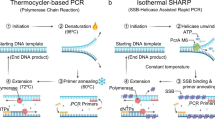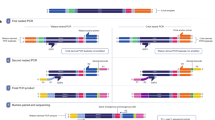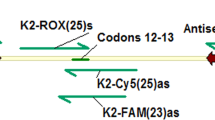Abstract
The polymerase chain reaction (PCR) technique has become an indispensable method in molecular research. However, PCR-amplification of GC-rich templates is often hampered by the formation of secondary structures like hairpins and higher melting temperatures. We present a novel method termed 'Slowdown PCR', which allows the successful PCR-amplification of extremely GC-rich (>83%) DNA targets. The protocol relies on the addition of 7-deaza-2′-deoxyguanosine, a dGTP analog to the PCR mixture and a novel standardized cycling protocol with varying temperatures. The latter consists of a generally lowered ramp rate of 2.5 °C s−1 and a low cooling rate of 1.5 °C s−1 for reaching an annealing temperature and is run for 48 cycles. We established this protocol as a versatile method not only for amplification of extremely GC-rich regions, but also for routine DNA diagnostics and pharmacogenetics for templates with different annealing temperatures. The protocol takes 5 h to complete.
This is a preview of subscription content, access via your institution
Access options
Subscribe to this journal
Receive 12 print issues and online access
$259.00 per year
only $21.58 per issue
Buy this article
- Purchase on Springer Link
- Instant access to full article PDF
Prices may be subject to local taxes which are calculated during checkout



Similar content being viewed by others
Change history
13 August 2009
In the version of this article initially published, the center and right-hand panels of Figure 1 were incorrectly drawn; the orientation of the cycles and the placement of the connecting arrows were incorrect. Also, in the bottom cycle of the center panel, the annealing temperature 58 °C should have been presented as "y °C". Finally, in the last sentence of the legend for Figure 1, "from 70 to 53 °C" should have read ""from 70 to 54 °C". These errors have been corrected in the HTML and PDF versions of the article.
References
Mullis, K.B. & Faloona, F.A. Specific synthesis of DNA in vitro via a polymerase-catalyzed chain reaction. Methods Enzymol. 155, 335–350 (1987).
Saiki, R.K. et al. Primer-directed enzymatic amplification of DNA with a thermostable DNA polymerase. Science 239, 487–491 (1988).
Roux, K.H. Optimization and troubleshooting in PCR. PCR Methods Appl. 4, S185–S194 (1995).
McDowell, D.G., Burns, N.A. & Parkes, H.C. Localised sequence regions possessing high melting temperatures prevent the amplification of a DNA mimic in competitive PCR. Nucleic Acids Res. 26, 3340–3347 (1998).
Varadaraj, K. & Skinner, D.M. Denaturants or cosolvents improve the specificity of PCR amplification of a G + C-rich DNA using genetically engineered DNA polymerases. Gene 140, 1–5 (1994).
Hapgood, J.P., Riedemann, J. & Scherer, S.D. Regulation of gene expression by GC-rich DNA cis-elements. Cell Biol. Int. 25, 17–31 (2001).
Bachmann, H.S., Siffert, W. & Frey, U.H. Successful amplification of extremely GC-rich promoter regions using a novel 'slowdown PCR' technique. Pharmacogenetics 13, 759–766 (2003).
Frey, U.H. et al. A novel promoter polymorphism in the human gene GNAS affects binding of transcription factor upstream stimulatory factor 1, Galphas protein expression and body weight regulation. Pharmacogenet. Genomics 18, 141–151 (2008).
Frey, U.H. et al. Characterization of the GNAQ promoter and association of increased Gq expression with cardiac hypertrophy in humans. Eur. Heart J. 29, 888–897 (2008).
Bachmann, H.S. et al. The AA genotype of the regulatory BCL2 promoter polymorphism (938C>A) is associated with a favorable outcome in lymph node negative invasive breast cancer patients. Clin. Cancer Res. 13, 5790–5797 (2007).
Nuckel, H. et al. Association of a novel regulatory polymorphism (-938C>A) in the BCL2 gene promoter with disease progression and survival in chronic lymphocytic leukemia. Blood 109, 290–297 (2007).
Riemann, K. et al. Comparison of manual and automated nucleic acid extraction from whole-blood samples. J. Clin. Lab Anal. 21, 244–248 (2007).
Saccone, S., De, S.A., Della, V.G. & Bernardi, G. The highest gene concentrations in the human genome are in telomeric bands of metaphase chromosomes. Proc. Natl. Acad. Sci. USA 89, 4913–4917 (1992).
Rychlik, W., Spencer, W.J. & Rhoads, R.E. Optimization of the annealing temperature for DNA amplification in vitro. Nucleic Acids Res. 18, 6409–6412 (1990).
Hube, F., Reverdiau, P., Iochmann, S. & Gruel, Y. Improved PCR method for amplification of GC-rich DNA sequences. Mol. Biotechnol. 31, 81–84 (2005).
Musso, M., Bocciardi, R., Parodi, S., Ravazzolo, R. & Ceccherini, I. Betaine, dimethyl sulfoxide, and 7-deaza-dGTP, a powerful mixture for amplification of GC-rich DNA sequences. J. Mol. Diagn. 8, 544–550 (2006).
Sahdev, S., Saini, S., Tiwari, P., Saxena, S. & Singh, S.K. Amplification of GC-rich genes by following a combination strategy of primer design, enhancers and modified PCR cycle conditions. Mol. Cell Probes 21, 303–307 (2007).
Sarkar, G., Kapelner, S. & Sommer, S.S. Formamide can dramatically improve the specificity of PCR. Nucleic Acids Res. 18, 7465 (1990).
Winship, P.R. An improved method for directly sequencing PCR amplified material using dimethyl sulphoxide. Nucleic Acids Res. 17, 1266 (1989).
Pomp, D. & Medrano, J.F. Organic solvents as facilitators of polymerase chain reaction. Biotechniques 10, 58–59 (1991).
Henke, W., Herdel, K., Jung, K., Schnorr, D. & Loening, S.A. Betaine improves the PCR amplification of GC-rich DNA sequences. Nucleic Acids Res. 25, 3957–3958 (1997).
McConlogue, L., Brow, M.A. & Innis, M.A. Structure-independent DNA amplification by PCR using 7-deaza-2′-deoxyguanosine. Nucleic Acids Res. 16, 9869 (1988).
Chester, N. & Marshak, D.R. Dimethyl sulfoxide-mediated primer Tm reduction: a method for analyzing the role of renaturation temperature in the polymerase chain reaction. Anal. Biochem. 209, 284–290 (1993).
Lee, C.H., Mizusawa, H. & Kakefuda, T. Unwinding of double-stranded DNA helix by dehydration. Proc. Natl. Acad. Sci. USA 78, 2838–2842 (1981).
Fernandez-Rachubinski, F., Eng, B., Murray, W.W., Blajchman, M.A. & Rachubinski, R.A. Incorporation of 7-deaza dGTP during the amplification step in the polymerase chain reaction procedure improves subsequent DNA sequencing. DNA Seq. 1, 137–140 (1990).
Don, R.H., Cox, P.T., Wainwright, B.J., Baker, K. & Mattick, J.S. 'Touchdown' PCR to circumvent spurious priming during gene amplification. Nucleic Acids Res. 19, 4008 (1991).
Hecker, K.H. & Roux, K.H. High and low annealing temperatures increase both specificity and yield in touchdown and stepdown PCR. Biotechniques 20, 478–485 (1996).
Davies, H. et al. Mutations of the BRAF gene in human cancer. Nature 417, 949–954 (2002).
Jung, A., Ruckert, S., Frank, P., Brabletz, T. & Kirchner, T. 7-Deaza-2′-deoxyguanosine allows PCR and sequencing reactions from CpG islands. Mol. Pathol. 55, 55–57 (2002).
Freier, S.M. et al. Improved free-energy parameters for predictions of RNA duplex stability. Proc. Natl. Acad. Sci. USA 83, 9373–9377 (1986).
Rychlik, W., Spencer, W.J. & Rhoads, R.E. Optimization of the annealing temperature for DNA amplification in vitro. Nucleic Acids Res. 18, 6409–6412 (1990).
Caulfield, M. et al. Linkage of the angiotensinogen gene to essential hypertension. N. Engl. J. Med. 330, 1629–1633 (1994).
Cambien, F. et al. Deletion polymorphism in the gene for angiotensin-converting enzyme is a potent risk factor for myocardial infarction. Nature 359, 641–644 (1992).
Siffert, W. et al. Association of a human G-protein beta3 subunit variant with hypertension. Nat. Genet. 18, 45–48 (1998).
Zuker, M. Mfold web server for nucleic acid folding and hybridization prediction. Nucleic Acids Res. 31, 3406–3415 (2003).
Author information
Authors and Affiliations
Corresponding author
Rights and permissions
About this article
Cite this article
Frey, U., Bachmann, H., Peters, J. et al. PCR-amplification of GC-rich regions: 'slowdown PCR'. Nat Protoc 3, 1312–1317 (2008). https://doi.org/10.1038/nprot.2008.112
Published:
Issue Date:
DOI: https://doi.org/10.1038/nprot.2008.112
This article is cited by
-
Direct TAMRA-dUTP labeling of M. tuberculosis genes using loop-mediated isothermal amplification (LAMP)
Scientific Reports (2024)
-
Technical strategy for monozygotic twin discrimination by single-nucleotide variants
International Journal of Legal Medicine (2024)
-
Nodal is a short-range morphogen with activity that spreads through a relay mechanism in human gastruloids
Nature Communications (2022)
-
Genetic sex test for the short-beaked echidna (Tachyglossus aculeatus)
Conservation Genetics Resources (2022)
-
Oligo replication advantage driven by GC content and Gibbs free energy
Biotechnology Letters (2022)
Comments
By submitting a comment you agree to abide by our Terms and Community Guidelines. If you find something abusive or that does not comply with our terms or guidelines please flag it as inappropriate.



